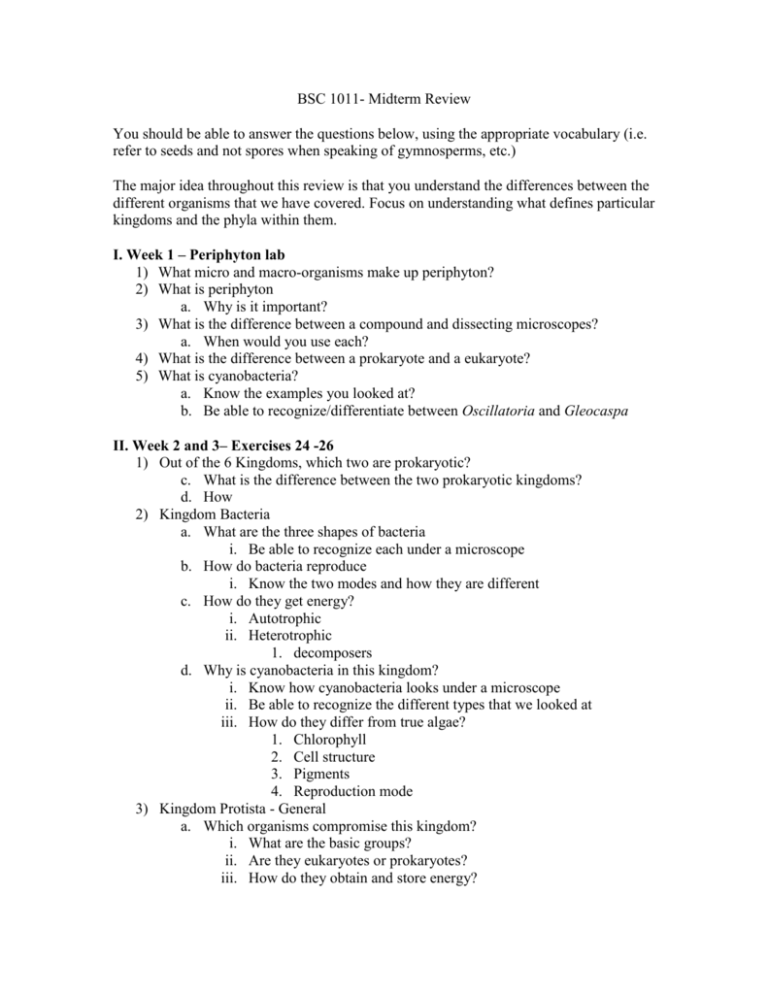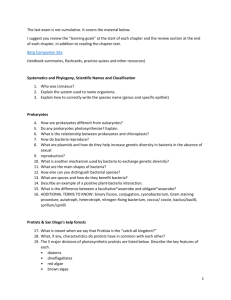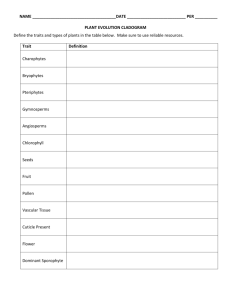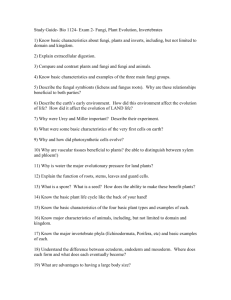BSC 1011- Midterm Review
advertisement

BSC 1011- Midterm Review You should be able to answer the questions below, using the appropriate vocabulary (i.e. refer to seeds and not spores when speaking of gymnosperms, etc.) The major idea throughout this review is that you understand the differences between the different organisms that we have covered. Focus on understanding what defines particular kingdoms and the phyla within them. I. Week 1 – Periphyton lab 1) What micro and macro-organisms make up periphyton? 2) What is periphyton a. Why is it important? 3) What is the difference between a compound and dissecting microscopes? a. When would you use each? 4) What is the difference between a prokaryote and a eukaryote? 5) What is cyanobacteria? a. Know the examples you looked at? b. Be able to recognize/differentiate between Oscillatoria and Gleocaspa II. Week 2 and 3– Exercises 24 -26 1) Out of the 6 Kingdoms, which two are prokaryotic? c. What is the difference between the two prokaryotic kingdoms? d. How 2) Kingdom Bacteria a. What are the three shapes of bacteria i. Be able to recognize each under a microscope b. How do bacteria reproduce i. Know the two modes and how they are different c. How do they get energy? i. Autotrophic ii. Heterotrophic 1. decomposers d. Why is cyanobacteria in this kingdom? i. Know how cyanobacteria looks under a microscope ii. Be able to recognize the different types that we looked at iii. How do they differ from true algae? 1. Chlorophyll 2. Cell structure 3. Pigments 4. Reproduction mode 3) Kingdom Protista - General a. Which organisms compromise this kingdom? i. What are the basic groups? ii. Are they eukaryotes or prokaryotes? iii. How do they obtain and store energy? iv. v. vi. vii. viii. 1. Heterotrophic or Autotrophic? 2. Photosynthetic? 3. Phagocytic? Are they multi-or-unicellular? Are they colonial? 1. Consider the volvocine line a. Know which organisms are part of that. 2. What does that tell you about evolution, organisms evolving from simpler to more complex forms? How do they reproduce? 1. Asexual and sexual? 2. Fission 3. Conjugation 4. Alternation of generations 5. Mitosis 6. Oogamy 7. Syngamy Algae 1. Be able to recognize the names of different phyla 2. Know how they look 3. Why are these algae in different phyla? a. Pigment stored b. Reproduction modes c. Cell complexity i. Unicellular vs. multicellular ii. Filamentous iii. Colonial 4. What is unique about Euglenophyta? 5. What is unique about Chrysophyta? Protozoans and Slime molds 1. Be able to recognize them under a microscope 2. What are the main differences between the phyla of protozoans? a. Mobility i. Pseudopods ii. Cilia iii. Flagella b. Reproduction i. Asexual and sexual 1. Fission 2. Conjucation c. How do they get energy? i. Heteroptrophic ii. Pathogenic? d. Do any of them produce any unique structures? 3. Why are slime molds in this Kingdom? a. How do they obtain energy? b. Are they multi-or-unicellular? c. How do they reproduce? 4) Week 3 – Exercise 27, Fungi a. Know the basic anatomy of fungi b. How do fungi obtain food/energy? i. What is the difference between a parasite and a saprophyte? ii. What are the cell walls of fungi made of? iii. What is the reproductive mode of fungi? 1. Asexual a. Budding vs fragmentation 2. Sexual a. Plasmogamy b. Karyogamy 3. What are the haploid cells that are used for reproduction, sexual and asexual? 4. How does sexual reproduction occur in Rhizopus? a. What is the product of two gametangia? b. How does it look? 5. Understand the basic reproduction cycle of all fungi iv. What is a lichen? 1. What relationship does it describe? 2. What composes it? 3. What advantages does this relationships have? 5) Week 4 – Kingdom Plantae, Exercise 28 and 29 a. What are some basic characteristics shared by members of the Kingdom Planta? b. How are they similar to and different from protists, bacteria or fungi? c. Why are bryophytes considered a primitive type of plant? d. What is vascular tissue and which groups have it? e. What is the life cycle of bryophytes? i. Which phase is dominant in bryophytes ii. How do they reproduce? 1. Sexually and asexually iii. How do the gametes come in contact? 1. Know the basic anatomy of bryophytes f. What is the difference between dioecious and monoecious? Which are liverworts, moss or ferns? g. Be familiar with what Marchantia thallus, archegoniophore, antheridiophore, and gemmae cups look like as whole parts h. How do ferns differ from bryophytes? i. Do they have seeds? ii. Are they vascular or not? iii. Do they have roots? iv. What is the dominant phase the fern life cycle? v. What is the mode of spore dispersal? i. What is the basic life cycle of ferns? i. Know the vocabulary as well as the stages of the life cycle ii. What is the “proper scientific” term for the valentine plant? 1. What is its function? 2. Are ferns dioecious or monoecious? 6) Week 5 – Gymnosperms and Angiosperms a. Gymnosperms –Exercise 30 i. What are the basic characteristics of gymnosperms? ii. How are they different from bryophytes and ferns? iii. Which organisms comprise the gymnosperms? 1. Why are some of these considered “living fossils”? iv. What is the basic life cycle of the Coniferophyta phylum? 1. What is the dominant phase? 2. What is the basic anatomy of the reproductive organs? a. How do the male and female organs differ? b. How do gametes come in contact? i. How do sperm differ between bryophytes and gymnosperms? c. Are they heterosporous or homosporous? b. Angiosperms – Exercise 31 i. What characteristics define angiosperms? ii. Know the anatomy of a flower iii. Understand what each part of a flower does iv. What is the difference between a monocotyledon and a dicotyledon? 1. Be able to categorize plants based on a picture v. What is unique about angiosperm reproduction? 1. Know the reproductive cycle and the associated vocabulary vi. What is a fruit? 1. Know the fruits that we have covered in the lab a. Be able to differentiate between fleshy and dry fruit b. Which fruits is pome, aggregate and multiple c. Which flower and fruit is hypo-peri-epigynous c. Plant anatomy – Exercise 32 i. Know the anatomy of a root 1. What is the function of each part (fig. 32.2) 2. What is the difference between a taproot system and a fibrous root system? a. Know an example for each 7) Week 6 – Walk to the preserve and WC conservatory a. Review the powerpoints that we used










